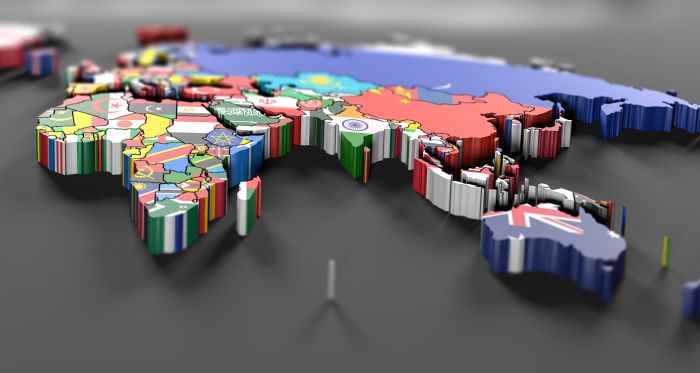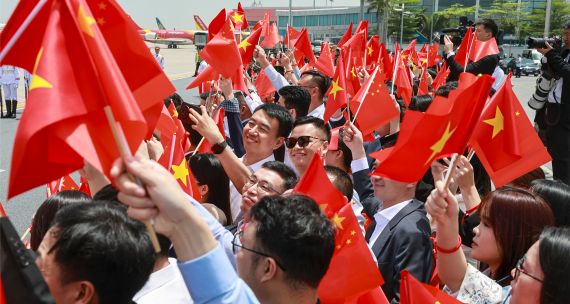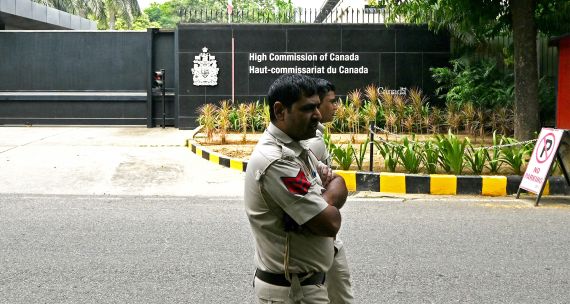On November 27, Canada’s Minister of Foreign Affairs, Mélanie Joly, announced Canada’s Indo-Pacific Strategy at a press conference in Vancouver. The long-awaited IPS identifies the Indo-Pacific as the world's most dynamic region, and argues that Canada’s national interests necessitate a whole-of-society, comprehensive approach to it. The IPS consists of five strategic objectives covering security, economics, social, and environmental priorities, and outlines initiatives designed to establish Canada as “an active and engaged partner” for Asian states.
In addition to its objectives, the IPS articulates the Trudeau government’s approach to China, the North Pacific, India, and ASEAN. Notably, the IPS’s treatment of China is markedly more stringent than the government’s past approach. So, too does the IPS’s focus on Southeast Asia mark a geographic realignment of Canada's priority engagement in Asia.
To realize its strategic aims, the Trudeau government allocated C$2.3 billion to fund initiatives. This funding is clear evidence the federal government is serious about better positioning Canada to be an active player in Asia.*
To provide insight into the IPS’s strengths and weaknesses, the Asia Pacific Foundation of Canada (APF Canada) invited some of our Distinguished Fellows, along with APF Canada's Vice-President, Research & Strategy, Dr. Jeff Reeves, to provide their preliminary thoughts. Specifically, APF Canada asked the contributors to consider the following questions:
- Do you feel the IPS better positions Canada to work more effectively in Asia in the near- to medium-term?
- What aspects of the IPS do you find the most compelling?
- What aspects of the IPS concern you?
* In the interest of transparency, it should be noted that among the initiatives announced for funding under the Indo-Pacific Strategy, APF Canada is to be provided with C$24.5 million to support the establishment of a physical presence and new engagement programs in the region.
Jeff Reeves, Vice-President, Research and Strategy, Asia Pacific Foundation of Canada
 From my perspective, the Strategy's real strengths are in its initiatives. If the Trudeau administration is serious about advancing Canadian interests in Asia—which it clearly is—it needs to focus more on programming that results in greater Canadian enmeshment throughout the region. Any activity, project, or engagement that leads to a new relationship, whether at the regional, state, or substate level, has the strategical effect of strengthening Canada’s status within Asia. The more Canada focuses on actional outcomes over strategic ideologies, the more it can develop partnerships that advance its national interests and benefit Asian states. The list of initiatives the Strategy identifies will go a long way towards building this basis for Canadian engagement in the region.
From my perspective, the Strategy's real strengths are in its initiatives. If the Trudeau administration is serious about advancing Canadian interests in Asia—which it clearly is—it needs to focus more on programming that results in greater Canadian enmeshment throughout the region. Any activity, project, or engagement that leads to a new relationship, whether at the regional, state, or substate level, has the strategical effect of strengthening Canada’s status within Asia. The more Canada focuses on actional outcomes over strategic ideologies, the more it can develop partnerships that advance its national interests and benefit Asian states. The list of initiatives the Strategy identifies will go a long way towards building this basis for Canadian engagement in the region.
I am particularly impressed with the initiatives related to sustainable development, people-to-people ties, and academic exchange, as they are entirely in line with the priorities of those in the region.
On sustainable development, the Shared Ocean Fund and FinDev Canada will help provide much needed funding to address illegal, unreported, and unregulated (IUU) fishing and for sustainable infrastructure in Asia, respectively. Canadian prioritization of the Indo-Pacific in the Powering Past Coal Alliance will also position Canada to provide guidance on transitioning from coal power to clean energy. Support for Canadian micro, small, and medium enterprises through the Advancing International Clean Technology Demonstration in the Indo-Pacific initiative is another thoughtful means to promote Canadian national interests and to address regional demand.
On people-to-people ties, initiatives to speed up visa processing and to facilitate travel will also pay dividends for Canada’s engagement in the region. Expanded SEED scholarship programs and studentship opportunities that lead to permanent residency will increase Canada's visibility and desirability in Asia as a destination for potential study and/or immigration. For those of us who spend time in Asia, these initiatives answer the clear desire one repeatedly hears for increased opportunity to travel to, study in, or immigrate to Canada.
On academic exchange, the Strategy’s Indo-Pacific Regional Engagement initiative, once fully realized, will help deepen Canada's ties with Asian institutions, universities, think-tanks, and research centres. These ties, in turn, will provide Canadian academics and scholars greater opportunity to engage in Asia and for Asian scholars to spend time in Canada, thereby creating a Canada-Asia knowledge network.
Where this Strategy’s strengths are in its initiatives, its weaknesses are in its strategic framing, particularly with respect to regional security and China. Canada stands to gain very little by securitizing aspects of its approach to Asia, particularly when it does so in co-ordination with the United States, not in line with demand coming from within the region. Canada’s decision to expand its naval footprint in Asia and its plan to establish a diplomatic position in Hawaii, in this respect, are less about supporting Asian states’ security than they are about Western state alignment. One finds no demand in the region for a more robust Canadian security role in Asia. Rather, one finds repeated concern over American provocation on matters ranging from North Korea and Taiwan to the South China Sea. Canada would do better to focus its Strategy entirely on non-security engagement.
Neither is it in Canada’s national interests to identify its Indo-Pacific Strategy as ‘inseparable’ from its approach to China, which, according to the Strategy, is primarily adversarial. While Canada-China relations are indeed problematic, choosing this Strategy as the time and place to declare a more assertive Canadian position toward Beijing undermines its other more positive aspects as it relegates all other Asian states to secondary status—clearly not the Strategy’s aim. That Canadian and international media coverage of the Strategy has to date focused exclusively on its China component is evidence this approach was counterproductive.
Overall, there are many good things in this Strategy. From my perspective, it is at its best when it focuses on what Canada can do in the region to strengthen state capacity and to raise living standards. It is at its worst when it attempts to recreate other Indo-Pacific strategies, particularly the U.S.’s, which are predicated on great power politics and the need to challenge China in Asia.
Bart Édes, Professor of Practice, McGill University
 The Indo-Pacific Strategy marks a milestone in Canadian foreign policy by ratcheting up the priority of Asia and the Pacific. A key strength is its comprehensive approach, weaving together Canadian interests across several critical domains. The Strategy strongly endorses the rules-based international order and highlights the importance of partnerships, such as continuing co-operation with Japan on development through the Asian Development Bank. This makes sense, but Canada should also work more closely with other bank shareholders to harness the institution’s great capacity to mobilize substantial funding for infrastructure.
The Indo-Pacific Strategy marks a milestone in Canadian foreign policy by ratcheting up the priority of Asia and the Pacific. A key strength is its comprehensive approach, weaving together Canadian interests across several critical domains. The Strategy strongly endorses the rules-based international order and highlights the importance of partnerships, such as continuing co-operation with Japan on development through the Asian Development Bank. This makes sense, but Canada should also work more closely with other bank shareholders to harness the institution’s great capacity to mobilize substantial funding for infrastructure.
The Strategy states that Canada will give particular attention to building capacity to engage with several countries, including in Southeast Asia. This is a sensible approach, given that ASEAN will soon become the world’s fourth largest economy and boasts great geopolitical importance. Through the Comprehensive and Progressive Agreement for Trans-Pacific Partnership (CPTPP), and an anticipated Canada-ASEAN free trade agreement, Canadian businesses can increasingly use ASEAN as a platform to enter the enormous Chinese market.
Debate will rage about whether the right notes have been struck vis-à-vis China, which the Strategy describes as a “disruptive power” that disregards international rules. Yet the Strategy also recognizes that involvement of the Asian giant is indispensable to solving critical global challenges. Hawkish elements of the Strategy are being welcomed in Washington, but could further complicate Ottawa’s sour relations with China.
The real measure of the Strategy’s success will be effective implementation and co-ordination with other federal initiatives and policies (like the Feminist International Assistance Policy). Canada’s public and private sectors have increasingly targeted Asia for bilateral trade and direct investment, but with only modest gains to date. Thus, plans to open an office to increase Canadian agriculture and agri-food exports to Asia is a wise investment.
The Strategy is grossly underfunded given its ambitions and regional focus. For example, the C$750 million allotted to FinDev Canada to expand its lending capacity in Asia is laudable, but too modest considering Canada’s role in the G7 Partnership for Global Infrastructure and Investment, and the massive capital boost provided by the U.S. to its own version of FinDev.
In sum, the Indo-Pacific Strategy represents an appropriate repositioning of Canada’s foreign policy priorities. The country’s future will increasingly be tied to international engagement outward from its Pacific Coast. Ottawa now must follow through on specific plans set forth in the Strategy, rally domestic support, and prove to skeptical Asian and Pacific audiences that Canada is serious about realizing its Pacific vision.
Danielle Goldfarb, Vice-President, Global Affairs, Economics, and Public Policy, Real-Time Interactive Worldwide Intelligence (RIWI)
 The most important thing about the Indo-Pacific Strategy is that it provides a foreign and trade policy direction. The Canadian public, the private sector, the public service, and other countries know that the government is prioritizing a list of specific activities to promote deeper engagement with the countries of the region. The fact that the Strategy provides guidance and funding across so many areas, including climate, trade and investment, and security, is also good news.
The most important thing about the Indo-Pacific Strategy is that it provides a foreign and trade policy direction. The Canadian public, the private sector, the public service, and other countries know that the government is prioritizing a list of specific activities to promote deeper engagement with the countries of the region. The fact that the Strategy provides guidance and funding across so many areas, including climate, trade and investment, and security, is also good news.
As a democracy with a small, open economy, Canada is dependent on global markets to grow its citizens’ living standards and also has a strong stake in a stable, rules-based international order. Deeper engagement with the faster-growth economies of the Indo-Pacific makes sense. So does the suite of actions in the document aimed at defending and advancing the rules-based international order.
The real challenge will be to advance these long-standing imperatives in the face of geopolitical and geographic realities. China is a global power that does not play by the rules in which Canada has a profound stake. While the early years of Prime Minister Trudeau’s mandate focused on pursuing a Canada-China free trade deal, the imprisonment of the “Two Michaels” has made it clear that this country needs a more nuanced approach. The Strategy plans investments in deepening diplomats’ understanding of how China operates, in growing Canada’s presence in other parts of the region, and in advancing global and regional agreements. It is not clear if this will be enough to advance Canadian interests, but these actions move Canada in the right direction.
The other reality — unmentioned in the document — is that Canada shares a border with the world’s largest economy. While the Strategy talks about diversifying beyond China, the reality is that Canadian companies do most of their business with the U.S. Generations of policymakers have tried and failed to meaningfully broaden Canada’s trade beyond the U.S. market. An orientation towards the Indo-Pacific will therefore not be easy.
One thing the Strategy should go farther on is the global digital and services economy. There are many references to growing agricultural and resource trade, but only brief mention of the opportunity to trade services — including digitally — in the region. Significant value comes from things that are more difficult to see and measure: ideas, data, research, and expertise. Canada has a major advantage here: personal connections. One in five Canadians have roots in the region. While the Strategy outlines many activities to strengthen and expand these connections, these could be more explicitly connected to leveraging these possibilities. Related to this, the Strategy should do more to place Canada at the forefront of advancing rules for the digital economy, including, for example, ensuring that data for commercial flows can move freely while respecting security and privacy.
In short, while the path ahead will not be easy, Canada now has a plan aimed at protecting and advancing Canadian interests.
Stéphanie Martel, Assistant Professor, Political Studies, Queen’s University
 The IPS is an impressive, comprehensive document that tackles a broad spectrum of issue-areas, outlines a much clearer direction to our engagement of various sub-regions and partners, with resources to match. It includes several promising, creative initiatives that will bolster Canada’s visibility in the region. Still, some components of the Strategy will likely lead to some setbacks, which may not have been fully anticipated. This has less to do with the nature of the initiatives announced than the general framing of the Strategy, and the balance it intends to strike between confrontational and co-operative aspects, especially with regards to China.
The IPS is an impressive, comprehensive document that tackles a broad spectrum of issue-areas, outlines a much clearer direction to our engagement of various sub-regions and partners, with resources to match. It includes several promising, creative initiatives that will bolster Canada’s visibility in the region. Still, some components of the Strategy will likely lead to some setbacks, which may not have been fully anticipated. This has less to do with the nature of the initiatives announced than the general framing of the Strategy, and the balance it intends to strike between confrontational and co-operative aspects, especially with regards to China.
The Strategy does best when it outlines specific, targeted, and creative co-operative initiatives that speak back to its key objectives and the broader principles underpinning Canada’s foreign policy, while also catering to regional demand. These include, among others, the establishment of a regional office for the Asia Pacific Foundation of Canada, support for Canadian expert participation in policy dialogues (although the nature of this support needs to be clarified), the development of collaborations between Canadian and regional civil society organizations, oceans management initiatives focused on IUU fishing and plastic pollution, and the expansion of the scholarships program. The focus on the promotion of the Women, Peace, and Security (WPS) agenda in the region, with Southeast Asian partners in mind, is also promising, although I expected more substance on this front. ASEAN just released a Regional Action Plan on WPS, so Ottawa’s timing is quite good, so long as it is mindful of regional sensitivities that inevitably arise when Western states promote liberal “human security” initiatives.
Canada seems to have effectively shut the door, in the near to medium term, on the possibility that China can act as a constructive player on the global stage, while at the same time stating that co-operation with Beijing on key issue-areas, like climate change, is not only possible but a necessity. A shift to a more confrontational tone on China, while rooted in legitimate concerns about Beijing’s behaviour, also provides a convenient justification for allocating all these resources to a region that appears so far away for many Canadians. But it also creates significant tension with the co-operative aspects of the Strategy. Branding China as a “security threat” certainly aligns with Washington’s view, but it is not as clear as Ottawa suggests that all of our closest partners share this assessment, at least to this extent. This stance is going to complicate Canada’s attempts to overturn a perception in the region’s policy circles that it is nothing more than a “mini U.S.,” and to convince ASEAN, in particular, that “more Canada” is actually needed in key fora, given ASEAN's penchant for a non-confrontational, inclusive approach to regional affairs. I’m not sure how Ottawa is going to be able to walk that tightrope.
Hugh Stephens, Principal, TransPacific Connections
 The Strategy is the first multi-year, costed, and funded overall plan for a whole-of-country engagement with the expanded region that I am aware of, and it is welcome. It is comprehensive and addresses all the key sectoral areas of engagement from security to economic to people-to-people to climate change and institutional presence, as well as redirecting geographic focus to Southeast and South Asia, while maintaining strong linkages with key North Pacific economies, such as Japan, Korea, and Taiwan.
The Strategy is the first multi-year, costed, and funded overall plan for a whole-of-country engagement with the expanded region that I am aware of, and it is welcome. It is comprehensive and addresses all the key sectoral areas of engagement from security to economic to people-to-people to climate change and institutional presence, as well as redirecting geographic focus to Southeast and South Asia, while maintaining strong linkages with key North Pacific economies, such as Japan, Korea, and Taiwan.
It reassesses Canada’s ongoing important relationship with China, setting parameters for engagement while recognizing the key role that China will continue to play in the region. To me, what is important is that while the Strategy will provide significant additional resources for activities and exchanges in the region, including an enhanced physical presence, it also recognizes the need for additional funding for domestic-based activities that are related to issues connected to Canada’s engagement with the region. These include defensive measures such cybersecurity, combating foreign interference and hostile activities on Canadian soil, increased vigilance against terrorism, and closer review of foreign investment, but also proactive measures such as encouraging engagement by Canadians with the region through Track 2 activities, sharing of expertise, and educational exchanges. The Strategy will raise expectations in the region; the key will be delivery. We have proclaimed a role in the region before — although not to this extent and with this degree of financial and apparent policy commitment — and we cannot allow this to become yet one more episodic exercise where we don’t deliver.
The most compelling elements of the Strategy are its recognition of the necessity for an integrated approach by Canada to the region, and the significant commitment of multi-year funding allocated to it. In the past we have had trade promotion, or traditional security, or development assistance initiatives, but there has never been a “whole-of-government,” indeed a “whole-of-country” (for many of the activities lie outside the direct purview of government departments) approach. What is also significant is a recognition of the peace and security dimensions which must underpin any economic, development assistance, or people-to-people approach. I also appreciate the recognition of the role that individual Canadians, experts, and institutions can play in establishing bridgeheads and building bridges. I look forward to learning more about the Regional Engagement Initiative. Finally, recognition of the need for “boots on the ground” is important, through the establishment of a new APF Canada office in the region (with Singapore understood to be the currently-planned location), the Regional Trade Gateway, and additional diplomatic resources in the region.
While the Strategy lays out a wide range of commitments and activities, key will be execution and accountability. At the moment, many details of the Strategy are lacking. It will inevitably take time for the Strategy to gain momentum, and it is essential that delivery mechanisms be put in place as quickly as possible. There should be aspirations for an “early harvest” in some areas. For example, while the Regional Engagement initiative, through which “a broad range of Canadian sector leaders, subject-matter experts, academics and civil society groups will be able to build new networks in the Indo-Pacific, strengthen the Canadian voice on priority issues and create partnerships on behalf of Canada” is very welcome, there is no information as to allocation of funding, means of delivery, priority sectors, or any other concrete information that would allow the named groups to start preparing to access the program.
Given the wide scope of the Strategy, it is also imperative that results be identified, tracked, and reported on in an integrated and comprehensive manner. Goals should be identified, and results measured against them annually and across the duration of the Strategy. Perhaps this could be one of the areas of responsibility for the new special envoy for the Indo-Pacific Strategy, who is to be named. It is surprising that that position was not filled and the envoy ready to begin implementation on the day the Strategy was released.
Sharon Zhengyang Sun, Trade Policy Economist, Canada West Foundation
 For a country where trade accounts for 60.9 per cent of its GDP, the commitment to increase presence, investment, and understanding in the world’s fastest-growing economic region is a good and necessary start for Canada’s long-awaited Indo-Pacific Strategy. While it is important to wait and see how the implementation will roll out, the strategy contains some compelling and promising aspects. These include:
For a country where trade accounts for 60.9 per cent of its GDP, the commitment to increase presence, investment, and understanding in the world’s fastest-growing economic region is a good and necessary start for Canada’s long-awaited Indo-Pacific Strategy. While it is important to wait and see how the implementation will roll out, the strategy contains some compelling and promising aspects. These include:
- Increasing presence and understanding in the region through new gateways and offices such as new Team Canada Missions and the Canadian Trade Gateway in Southeast Asia.
- Clearly identifying and strengthening economic ties with existing allies in the region.
- Recognizing the need to develop better trade infrastructure in Canada with some commitments, such as the National Trade Corridors Fund.
- Remaining in dialogue with China and engaging economically with eyes wide open; more importantly, there is no explicit language of decoupling from China.
Remaining in dialogue versus active engagement is very different. Remaining in dialogue with China is barely enough to manage relations with our second-largest trading partner. The commitment to increase Canadian competencies and understanding of China at every level (government, industry, academia) is of the utmost importance for Canada to survive in a world where China is the largest trading partner and economy in the world. While the strategy identified this clearly, it allocates no investments or resources toward China. There is no explicit mention of China under the new Team Canada trade missions like there is for India, ASEAN, Japan, and South Korea. Neither is there an increase in visa-processing capacity for student permits or renewing student permits for China, as there is for India, Pakistan, and the Philippines. This signals that despite the lack of decoupling language, Canada is not looking to expand its relations with China, nor is the government pushing to increase trade within the Chinese market. Instead, the emphasis is to work with businesses to diversify within and beyond China.
As a trade-reliant small country with limited resources, the “not having all your eggs in one basket” diversification mentality makes sense. Yet despite efforts to diversify away from the U.S., the country remains our largest trading partner accounting for 62 per cent of Canada’s total two-way trade. A growing global hegemon that is the largest trader and investor in South, East, and Pacific Asia – as well as North America, the Middle East and Africa – China is here to stay. Without explicit and real investment in time and resources at every level on China, we will fall behind our allies, who are also our competitors in China and in the region.
Further, what applies to China in the Indo-Pacific Strategy should apply to other Southeast Asia nations. Issues of human rights, forced labour, SOEs, and unfair trade practices exist in these Asian countries that the IPS has identified as key partners. Yet, there were no discussions of these issues nor how to manage them with India, the Philippines, or Myanmar, just to name a few. India’s Canadian peas ban in 2017 had a similar, if not worse, impact as China’s canola ban, and these issues persist today. The FTA negotiation stalls with Indonesia on addressing labour standards also demonstrates the difficulty and the reality of engaging in these issues in the region. Canada needs to approach Southeast Asia nations in an equally realistic and clear-eyed assessment as it has indicated for China.
Finally, the Comprehensive and Progressive Agreement for Trans-Pacific Partnership (CPTPP) was not cited in the Indo-Pacific Strategy as a key tool to encourage new regional economies to participate. The CPTPP is the “gold standard,” the most comprehensive agreement in the Indo-Pacific region, and one of which Canada is a part. The CPTPP gives Canadian businesses everything American businesses want – but will not have. These are real, ratified, and implemented tariff and non-tariff measures. These are high labour and environmental standards with key economies in the region. The strategy should prioritize the CPTPP as a proactive tool to encourage non-members in the region to join.










